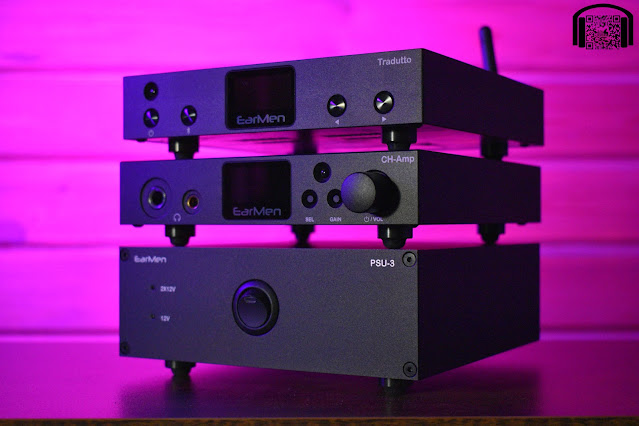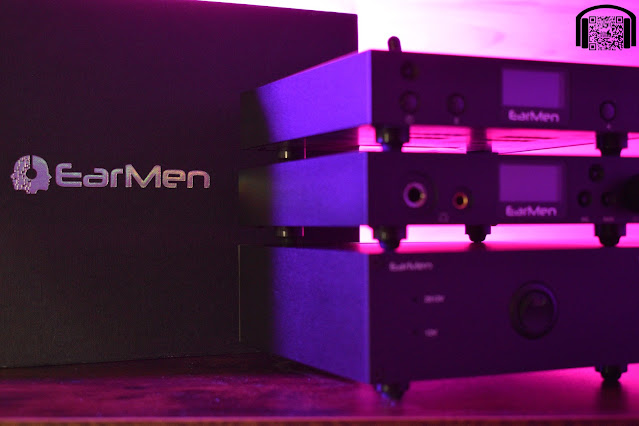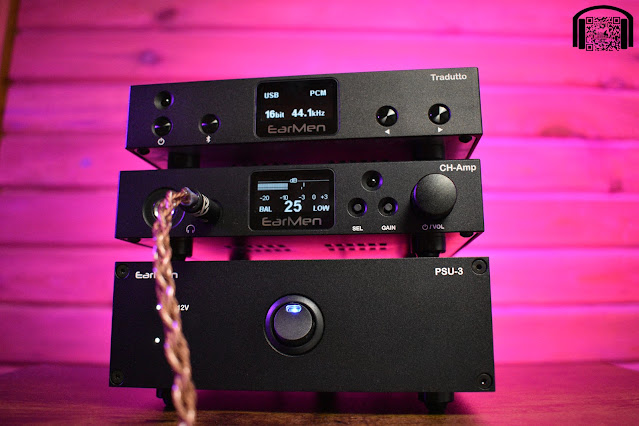As there doesn’t seem to be a thread for this desktop amplifier, I will create this new thread and leave my review of it here…
TLDR version on YouTube: TDLR - Earmen CH-Amp
The Earmen CH-Amp has been sent to me directly by Earmen for me post my opinions in this review. Earmen have not requested anything specific and, as always, I will do my very best to be as unbiased as humanly possible.
You can find the official page for the CH-Amp here: EarMen CH-Amp
As with all links that I share, this is a non-affiliate link, meaning I do not receive anything in exchange for clicks or purchases.
Intro…
Not long ago I reviewed the Earmen Tradutto, a DAC that I found (and find) to be very good, fitting my tastes and working well with all of the systems and set ups that I have at home. I said that my biggest issue with it was that I couldn’t decide where I wanted it as I liked it with all of my set ups.
Well Earmen very kindly decided to send along the CH-Amp, the headphone amplifier that is from the same desktop line and is designed to form a stack with the Tradutto DAC and, although it is a spoiler, Earmen have managed to decide for me where the Tradutto should live.
The CH-Amp is not the most economical of desktop amplifiers, with a retail price of just under $1500, although it is currently on sale direct from Earmen for $999, but it definitely has a lot going for it. Not only is it an amp that performs very well, it also has plenty of connectivity and even comes with an external low noise linear power supply, which is something that is usually a separate purchase when wanting to include one in your system, so the price starts looking quite favourable when taking it all of into account.
So, after almost a month of using the Earmen stack almost daily, and a lot of patience from Earmen as they have never asked when I am going to get around to reviewing it, here are my impressions.
Presentation…
As with the Tradutto, the unboxing of the CH-Amp proves that they put a lot of care into their packaging and presentation. There is nothing really specially about it, just that the whole procedure makes you feel like you are opening something that has been packaged with care.
Upon removing the (very heavy) box from the cardboard sleeve that shows images of the two units, along with more details, the lid flips up to show the first layer of thin cardboard underneath which, we find the user manual.
Beneath this first layer, we lift up the first layer of foam protection to reveal the amplifier in a cutout on the left side of the box and the included remote to the right, both extremely well protected.
After taking the amplifier out of the box (and the remote), underneath these we get even more protective foam which covers the linear power supply (again surrounded by foam) in the bottom with a box containing the cables to the right. The included cables are for power only but they include the necessary cables to power up to 4 components from the linear power supply. I will discuss more about this in a moment.
In general, as I said, it is not that there is anything special about the unboxing, it’s the amount of care and protection that has been put into the boxing of the devices which makes you feel like you have received something special.
Build and aesthetics…
The build and the aesthetics are an exact match for the Tradutto DAC, as these are designed to become a stack. I said when I reviewed the Tradutto that the aesthetics were more aimed at blending in than standing out, and that is still the case, except that now they are all stacked together, they do attract the eye.
With them stacked they very much remind me of the HiFi systems that I used to drool over when I was growing up (and later owned a few) just in a more compact set up. I have to say that I have had them on my desk at the side of me for the past month and I still enjoy looking at them. Again, they are not fancy designs, just 3 square black boxes with screens (two of them at least), but this mini HiFi stack just appeals to me. Simple yet cool.
Looking at the independent components, the amplifier is of the exact same dimensions as the DAC, with a matching screen that shows levels instead of bit rates. The screens are monochromatic but, again, there is something about there simplicity that I really like. No flashy coloured screens, just two bars that move to the rhythm of the music. These were the VU meters of my youth and while I do like (some) fancy aesthetics, these just attract me.
The power supply is of the same width and depth but with double the height, making the stack look like it is ready for business. While I am not overly keen on the blue LED of the power switch on the front (by the way, they all have their power on the front, hurray!), at least it is not so bright as to be annoying. Personally I would have preferred a white LED to match the indicator LEDs on the left (and the general vibe of the screens) but that is a minor complaint.
One thing that I will say is that these devices are heavy, all three of them! There is no risk of anyone ever knocking this stack off of the desk!
Functionality…
Let’s talk about the power supply first as it is quite simple. On the back of the unit there is an IEC input on the right of the device that is for the main incoming power (220V in my case). In the center we get 3x 12V outputs that can provide a total of 1.5A between them. Finally, on the left, we get a proprietary connector, well, it’s not really proprietary, just not a common cable you will find in your drawer, that outputs 2x 12V at 1.5A. This last connector is for powering the amplifier, whereas the normal 12V outputs can be used for powering the Tradutto or the Staccato (matching streamer) etc.
On the front of the power supply we have a main on/off switch (with a blue LED to indicate when powered on) with 2x small, white, LEDs to the left. One LED indicates that the normal 12V outputs are powered up and functioning, the other does the same for the 2x12V output (both labelled).
So, all you need to do is use the included cables and connect the 2x12V output to the CH-Amp and the other 12V outputs to any other Earmen devices you have in your stack (in my case the Tradutto). Flick on the power switch and away you go. Just as a warning, when you turn on the power supply before turning on the DAC (if relevant), Windows will give you an error message saying it doesn’t recognize the DAC. This error is resolved as soon as you turn on the DAC.
Ok, so now let’s look at the actual amplifier…
Starting from the front left, we get a 6.35mm unbalanced headphone output, then a 4.4mm balanced headphone output, the screen in the center, a button labelled “SEL”, a button labelled “GAIN” and finally, to the right, a voulme know that also works as a push button to mute (with a single press) or put the device in stand by (with a long press). When the unit has been muted and you unmute, the volume ramps up (stopping at any time if you touch the knob), which avoids sudden blasts of unexpected sound.
Moving around to the back, again from left to right, we have the power input, a 4.4mm balanced preamp output, an unbalanced preamp output on RCA’s, unbalanced input 1 (RCA’s), unbalanced input 2 (RCA’s) and then a balanced input (4.4mm).
As far as functionality, well first you hook up the relevant cables, turn on the power supply, press the volume knob and you are greeted with the Earmen logo on the screen as it boots. Once it has booted, the logo on the screen is replaced with two bars at the top that show the output level (digital VU meters in bar form), to the bottom left it indicates the current input, the center gives us the current level in digits (i.e: volume level, not dB level like the bars at the top), which go from 0 to 30, then in the bottom right corner it shows the current gain mode.
Turning the volume knob will obviously raise or lower the volume level, with a single press muting the device, the gain button switches between High and Low gain, while the SEL button cycles through the 3 available inputs (showing “BAL”, “L1” or “L2” on the screen).
All of this can also be done from the remote except for changing the gain. The only difference with the remote is that it has separate buttons for power and mute and has a + and - button for the input selection (it doesn’t cycle from the remote, you can go up or down).
One thing to note is that, when the unit has been off (or in stand by), when it comes back on, the volume level is automatically set to 0 (the same happens when plugging or unplugging headphones). There is a bit of a noise in headphones (and IEMs) when the unit is turned off or on from stand by mode. There is a relay that clicks as it it enters some kind of protection mode before turning off and also after it turns on, to protect headphones from power surges. This is great, but I did find that planar headphones weren’t overly happy when the relay clicked. It is not that it has done any damage to them but the noise you hear through planar headphones when it happens is not very enjoyable. With dynamic headphones (and IEMs), the noise is present but it doesn’t sound as scary as it does with planar headphones ![]() While I am not saying that the protection circuit will not work to protect planar headphones, I am sure Earmen have designed it to be more than capable, I do find that I prefer unplugging planars before entering stand by (and plugging them back in after it has booted).
While I am not saying that the protection circuit will not work to protect planar headphones, I am sure Earmen have designed it to be more than capable, I do find that I prefer unplugging planars before entering stand by (and plugging them back in after it has booted).
So, as far as functionality it is all simple and straightforward. I have praised the Echo amplifier in the past for having three inputs and the same praise goes for the CH-Amp, in this case, one of them is balanced, so even better. We also get balanced and unbalanced outputs with preamp functionality which solves the comment I had about the Tradutto being great for powered speakers but not having volume control, well now we do.
Sound…
While I have used various DACs to feed the CH-Amp, with the amplifier working well with all of them, the combination with the Tradutto DAC is certainly my preferred combination. We talk about synergy, which is very difficult to put into words but when something just clicks together, it just is. Could this be psychological? Of course. But as I have said before, I am more interested in what I feel I am experiencing than what % of it is just perception. This is to say that I have been using the CH-Amp paired with the matching Tradutto.
When I mentioned in the Tradutto review that I was struggling to decide where I wanted to place the Tradutto, as I liked it with all my systems, well, Earmen made that decision easy by sending the CH-Amp. The stack has been on my desk in the office and has been used daily, with all kinds of headphones and IEMs (both for pleasure and for review purposes), except when I have been testing other sources (in which case it has been a reference mark). In other words, I have spent many hours with this stack.
So, how would I describe the sound of the CH-Amp, especially when paired with the Tradutto?
I would say that it is just slightly on the warmer side of neutral. There is not a baked in warmth to the sound like we get with some other brands, nor is it cold or clinical like some other set ups I have on hand to reference. It is clean, detailed and very musical.
Again, it may be all in my head but when plugging into the CH-Amp, things just sound “right”. Of course, there is no “right” or “wrong” when talking about audio preferences, so this is highly personal, but I really feel that the Earmen stack has just the right balance between being very detailed and very enjoyable. Sometimes devices tend to exaggerate the presentation of details, making them become the center of attention, this is not like that. With very detailed tracks, using things like the Arya or the HE1000se, those details are very apparent, yet they don’t jump out at you and shout “listen to me!”.
Yet, connecting the Ananda (which I have always found to be a headphone that does put emphasis on detail and shout “listen to me!”), there is no rounding or smoothing of the Ananda’s performance, making it sound like the Ananda should.
With the HD6XX, there is no lack of that luxurious mid range that the headphones can produce (on the right day, when the stars align and I have had a good breakfast ![]() ), yet it is not smooth and fat (for lack of a better word) like it can be on a tube amp. Yes, I would still pick a tube amp for the HD6XX but only because I have heard the combo, not because there is anything wrong with the CH-Amp at all.
), yet it is not smooth and fat (for lack of a better word) like it can be on a tube amp. Yes, I would still pick a tube amp for the HD6XX but only because I have heard the combo, not because there is anything wrong with the CH-Amp at all.
The CH-Amp puts out a maximum of 3.5W which is plenty for anything that I have currently available and I have found absolutely no issue with lack of current for planars either. In fact, I haven’t found I needed to put it in high gain at all, although, admittedly, my listening levels are quite low.
With IEMs, which I have used a lot of since the stack has been on my desk, the result is also great. There is no background hiss, even with more sensitive sets, and at no point did I find that anything strange was happening with anything that I tried.
There is great extension down into the subbass, bass is fast and punchy even on planars, while mids are musical and highs are extended and smooth. If anything, I would say that the high end is actually a little smoother than on many other setups but it is not rolled off or dulled down, if a set of IEMs is harsh or brittle in the higher ranges, the CH-Amp does not fix it, but there is no way that it exaggerates the problem either.
In general, I think that the CH-Amp performs wonderfully in the sound department and I really can’t bring myself to find fault with it.
As far as the preamp output, which is only active when headphones are unplugged, I can’t say that I can spot the difference between using the preamp output of the CH-Amp versus going direct from the Tradutto. This is great news as I really like the output of the Tradutto and the CH-Amp seems to just add volume control to it.
Conclusion…
The CH-Amp is a great little amplifier that, paired with the Tradutto, really fits my taste and gives me anything I could need for my desk set up. I spend a minimum of 8 hours a day at my desk, using all kinds of headphones and IEMs, with speaker systems also available, and the stack gives me whatever I need when I need it.
The aesthetics are going to be a personal thing but I am a fan. Maybe it is a nostalgic thing for me as it really is like having a stack from my youth but in a smaller format on my desk. Sure, I would have preferred to skip the white text on the front of the devices but that is a very small complaint in comparison to all the praise that I can give this set up.
The normal retail price of this stack is $799 for the Tradutto plus $1,480 for the CH-Amp (including the power supply), so we are not talking about a cheap combo here. For almost $2,300 you have a lot of choice available, yet I feel that the Earmen line up is well deserving of being in the battle at that price. If we look at the current sale price (from Earmen direct at the time of this review), you can get the Tradutto for $499 and the CH-Amp for $999, which is almost $1,000 less and I think that takes from “good value” to just outright amazing!
As always, this review is available in Spanish both on my blog (www.achoreviews.com) and on YouTube (www.youtube.com/achoreviews)






